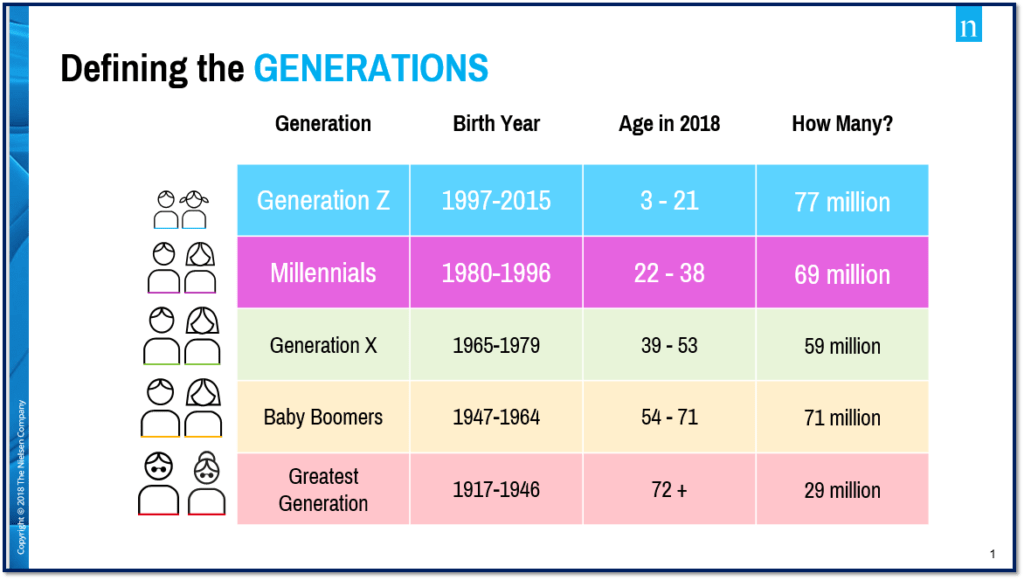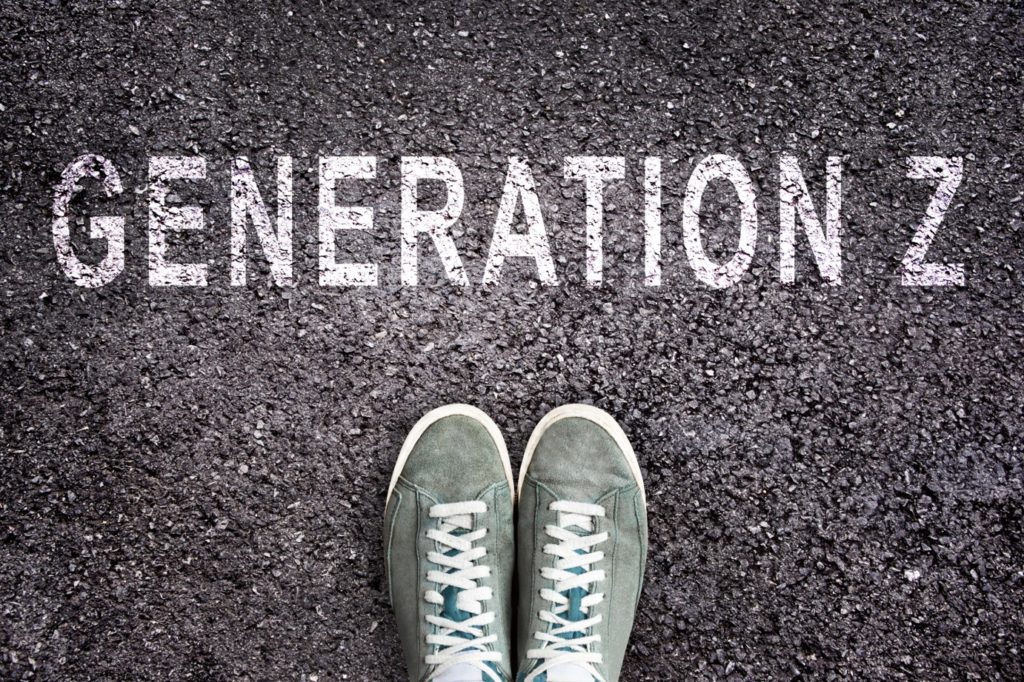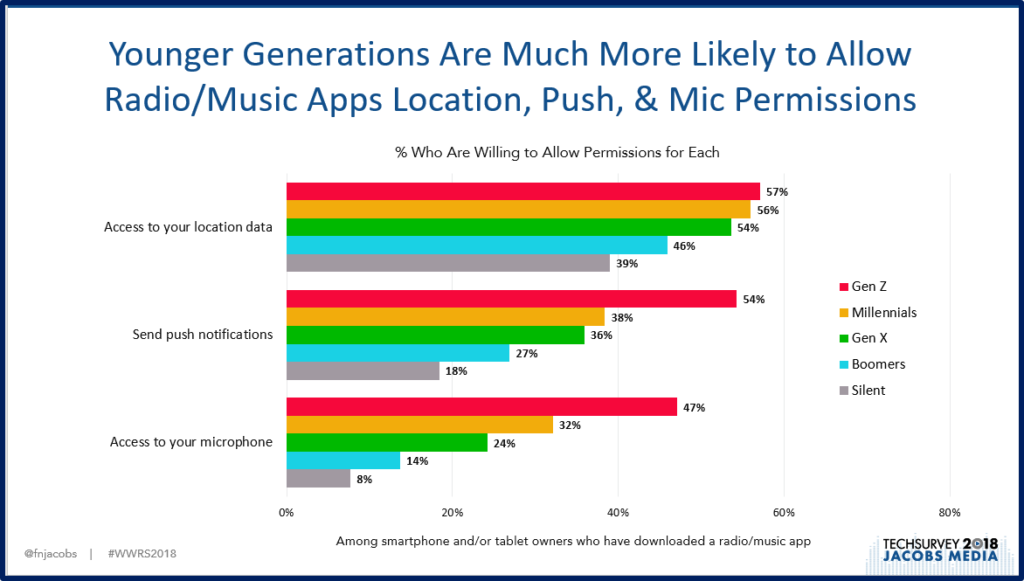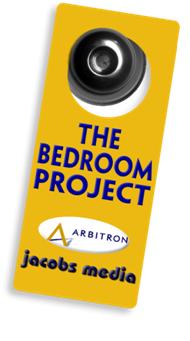
The chart of American generations you’re looking at might look a little weird to you. In fact, it’s dated. Really dated. It was first published by Nielsen seven years ago back in 2018.
It was a cautionary tale that ended up falling on the deaf ears of an industry too busy to stop the wheels of progress. In fact, radio as a medium continues to age like that steamship inevitably about to ram the iceberg known familiarly as Gen Z. If any major organization or company in broadcasting—TV or radio—has put together a viable strategy to address the industry’s “aging problem,” please remind me who that is.
While the radio industry is facing a number of truly existential challenges, this one has to be at the top of the list. In fact, unravelling the Gen Z mystery (and their younger Gen Alpha sibs) has stymied marketers of all types for many years running.
A brand new study by the eMarketer team confirms just how different this generation of Zs truly is. Back in 2023, they reached a milestone, representing 20% of the U.S. population—by the numbers, a force to be reckoned with.
But their messaging, marketing, content, and distribution habits set them apart. Social media plays an increasingly greater role in their discovery process, and they’re likely to apply a ton of research before making a decision.
My favorite takeaway from the eMarketer study? There are several of them, but the one I keep coming back to is their admonition to brands to “stand for something meaningful.” Mission-based organizations have an edge with Zs. In broadcasting circles, that points right at public radio and Christian stations.
Sadly, I can’t recommend “Gen Z: What marketers need to know about this generation” as good nighttime reading. In fact, the more you read it, it’s likely to keep you up.
Not to mention the night terrors and night sweats. – FJ
May 2018
I was never a math whiz, despite our company’s association with research, our many Techsurveys, and my occasional claims that I’m a “data whisperer.” But it doesn’t take a genius to look at the above chart and come to the quick conclusion there are even more changes just around the corner. It was presented by Nielsen’s talented VP, Audience Insights, Jon Miller, at Worldwide Radio Summit last week in Hollywood.
Take it from this aging Boomer, the bump in population among Gen Z should cause everyone in radio to look up from their Starbucks and oatmeal this morning and pay attention. For the last several years, we’ve been actively debating the power and import of Millennials. We often speak about them as kids, but the fact is, many have already been in the U.S. workforce well more than a decade.
In the meantime, their younger siblings (and in many cases, their children)—known as Gen Z—have already eclipsed Millennials in size, and perhaps soon, influence and societal impact.
For radio, this isn’t a good omen. As CMG’s Tim Clarke lamented at WWRS, radio execs often claim their expertise by quoting a 12-year old niece, rather than immersing themselves into new digital, social, and mobile platforms. And he’s right, of course. You can’t talk about technology—it has to become a vital part of your life—personally and professionally.
It’s also a truism that it’s not about anecdotes, but in the hard data that underscores how the U.S. population is changing fast. That’s why Techsurvey continues to mine Generation Z, despite the difficulty in finding them in radio station databases. Still, Techsurvey 2018 aggregated a sample of more than 650 of them who have something to do with radio. They only represent 1% of the overall sample, but they spoke with a big voice.
We’ve seen the phenomenon in stories like the Parkland teens who are trying to change the nation’s discourse about guns. On the other end of the spectrum, watch aging representatives of Congress try to ask intelligent and probing questions of Mark Zuckerberg a few weeks back. Their lack of understanding of social media and web basics underscores the technical generation gap—or call it an abyss—that separates youth from adults.
This hits home for me in an editorial in Adweek by 23 year-old Dari Kreitenberg earlier this month. A proud member of Gen Z, Dari goes off on Congress and older generations for their lack of understanding of today’s generation of youth. Here’s how she sees it from her perch:
“While memes of out-of-touch senators and op-eds from baby boomers to millennials expressing their opinions about privacy in the digital age are everywhere, it seems like we’re missing the opinions of those who were born in the digital age and grew up with social media: Generation Z.”
Radio’s much uttered “93% Argument” aside, Nielsen data already shows that while the vast majority of Millennials still cume broadcast radio every week, their usage numbers are eroding. Thinking about Gen Z, you have the right to start this week on a note of nausea.
But there are opportunities with Gen Z—if radio actually decided to research them, listen to them, and pay attention to them. When was the last time a broadcast radio-commissioned perceptual study included 12-17 year-olds (or younger)? The answer is never.
Many laughed at Arbitron when they originally went to 6+ measurement. It wasn’t funny—it was prescient. Radio operators may ignore these numbers, jumping to the 25-54 page, but the reality is that radio’s future may very well be dependent on its ability to connect with the nation’s kids, lest the industry goes the way of print.

All of a sudden, Facebook (and other high-profile hacks and breaches) are scaring older generations to their core. Privacy issues, exacerbated by these new data horror stories, are ominous and even terrifying.
Unless, that is, you’re a member of Generation Z.
As young Dari Kreitenberg cuts to the quick:
“As a Gen Zer, who was raised in an ever-changing digitized world, I can honestly say that many people my age have a different notion of privacy, the inner workings of Facebook’s privacy policy and its use of our information for targeted ads. We are a generation that covets immediacy, accessibility and instant gratification. Even more so, based off the way we live our lives, I think it’s safe to say that we believe that by virtue of using these platforms, we relinquished our right to privacy long ago.”
She reminds us a key to these permissions is the ability to control who sees their information—and for what duration (yes, think Snapchat).
Gen Z simply profiles differently from the rest of us—including even Millennials. When it comes to their use of mobile, social, and other platforms, they’re often in their own zone. We saw this in a new series of questions in Techsurvey 2018 where we measured “permissions” among our entire sample—for location-based, push notifications, and mobile phone microphone access.
Looking at this chart, it’s easy to see that Gen Z leads all other groups in their openness to these various online permissions. As Dari notes in her op-ed:
“As tech-natives, we are comfortable sharing personal moments through media. However, we still prefer a greater sense of control over who sees our data and for how long.”

My intention is not to start a 4-alarm fire over Generation Z. But my admonition to Xers and my fellow Boomers in radio is to stop telling stories about your children, grandchildren, nieces, and nephews. Instead, research them, observe them, listen to them, and start thinking about how a new cohort of Americans is already consuming, accessing, and enjoying media content.
I’ve heard too many of my aging colleagues shrug their shoulders and lament that the dilemma of future generations of radio listeners will be someone else’s problem. By then, they’ll be on the golf course, playing out what they hope will be a peaceful, prosperous, and happy retirement.
For their sakes, I hope so, too.
But for the sakes of their younger radio counterparts stuck with figuring out this demographic Rubik’s Cube, putting financial and human resources toward addressing what is an obvious demographic game-changer for an aging medium is of paramount importance—now.
 This is not a new issue for radio. Back in the year 2000—yes, 18 years ago—I put together a presentation for an NAB convention titled “Your 14 year-old thinks radio sucks.” Seven years later, Arbitron partnered with us to produce “The Bedroom Project,” radio’s first ethnographic study—an eye-opening series of videos that showed the industry how America’s youth were engaging with new technology, while radio was mostly an afterthought they checked out in their cars. Note this was before the advent of the “connected car.” Even back in 2007, you could easily spot the drift away from broadcast radio.
This is not a new issue for radio. Back in the year 2000—yes, 18 years ago—I put together a presentation for an NAB convention titled “Your 14 year-old thinks radio sucks.” Seven years later, Arbitron partnered with us to produce “The Bedroom Project,” radio’s first ethnographic study—an eye-opening series of videos that showed the industry how America’s youth were engaging with new technology, while radio was mostly an afterthought they checked out in their cars. Note this was before the advent of the “connected car.” Even back in 2007, you could easily spot the drift away from broadcast radio.
Sadly, nothing’s changed, and now we’re faced with a demographic deluge of adolescents who are already proving to be major consumers, as well as thought leaders as our society and culture are rocked by change.
I am confident we Boomers will solve our Social Security challenge in order to ensure we all receive our payouts.
It’s also our obligation to fix this Gen Z thing—or at least head down that road while it’s still open to us. Perhaps some radio companies are being manned by executives who are focused on Q2 performance. But many others are headed up by the children of radio visionaries who paved the way back in the ’60s and ’70s. They are today’s radio leaders tasked with solving this challenging problem—and industry groups should enthusiastically work closely with them to begin the process of figuring it out.
The numbers don’t lie. Add the Millennials and the Gen Z groups together, and you’ve got roughly half of the U.S. population right now today.
Radio needs a “Z Strategy.”
You can download eMarketer’s “Gen Z: What marketers need to know about this generation” here.
Originally published by Jacobs Media









